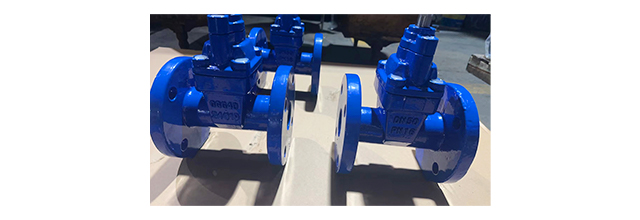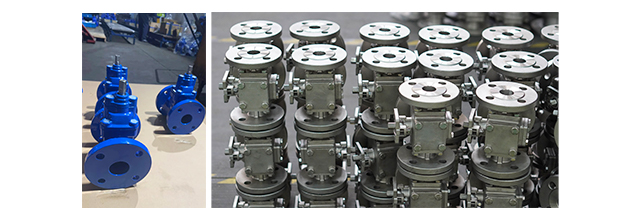- Gate valve
-
- DN1000 Extension stem double flange soft seal gate valveDIN F4 resilient seated gate valveDN450-1200 Resilient Seated Gate ValveDIN F5 resilient seated gate valveSocket connection soft seal gate valveUnderground cap soft seal gate valveBS5163 rising stem soft seal gate valveHard seal gate valveAPI slab Gate ValveStainless steel flange gate valveWafer knife gate valvePneumatic gate valveSoft seal gate valveExtension stem gate valveUL/FM fire protection groove ends gate valveRising stem forged steel gate valvecarbon steel gate valveStainless steel threaded gate valveDIN soft seal gate valveANSI soft sealing gate valve 200PSICast iron gate valveBS resilient seated gate valve
- Butterfly valve
-
- DN900 pneumatic triple eccentric hard seal butterfly valveD643H Triple Eccentric Butterfly ValveD343H Hard seal butterfly valveMulti standard EPDM seated butterfly valveSingle flange butterfly valveDN2000 Double eccentric butterfly valveFlange butterfly valveLug butterfly valveWafer butterfly valve with handleWorm gear operated butterfly valveWafer lined fluorine butterfly valveStainless steel wafer butterfly valveStainless steel flanged butterfly valveThree eccentric flange butterfly valvePneumatic flanged butterfly valvePneumatic wafer butterfly valveTriple eccentric butterfly valve wafer typeWafer butterfly valve ULC approvedInflatable seat butterfly valveHigh performance butterfly valveGrooved end butterfly valveElectric soft seal butterfly valveFlange fluorine lined butterfly valveHandle aluminum butterfly valveWorm Gear Aluminum Butterfly ValveFull PTFE lined butterfly valve wafer typeOne stem no-pin wafer butterfly valveMulti standard aluminum stem butterfly valveStainless Steel wafer Butterfly ValveAluminium handle operated lug butterfly valveLever Operated Flange Butterfly ValveButterfly valve stemButterfly valve discButterfly valve seat
- Ball valve
-
- DN1400 top-mounted eccentric semi-ball valveFlanged three-way ball valveFully welded ball valveNatural gas ball valveHigh platform flange ball valve1 PC ball valveFixed ball valvePTFE seat flanged ball valveMetal seat ball valveAPI 6D ball valve3 Piece ball valveFull Bore 3 way ball valve L-Port3 Way T-Port ball valve2PC Ball valve female thread stainless steel
- Globe Valve
-
- API Carbon Steel Globe ValveBellows Globe ValveStainless steel flange globe valveStainless steel thread S type globe valveStainless steel thread B type globe valveCast Steel Globe ValvePiston Globe ValveWCB Carbon Steel Globe Check Valveelectric motorized control stainless steel SS316 globe valveBrass Globe ValveCryogenic Globe valveHT200 Globe ValveThreaded Stainless Steel Globe ValveGG25 Globe ValveANSI API Cast Steel And Stainless Steel Globe valve
- Check valve
-
- Rubber seal check valveDN800 Slow closing check valveDN800 Rubber Disc Check ValveButterfly Buffering Check Valvecheck valve with counter weightSilent Check ValveWCB Swing check valveSwing Check ValveSingle Chip Check Valve H74WStainless Steel Wafer Check ValveSwing Start Check ValveFoot check valveAPI Swing Check ValveDIN Flange check valveSingle plate check valveLifting Check ValveBottom ValveHammer Diminish Noises Check ValveWafer Check ValveWafer dual plate check valve
- Control valve
-
- Static Balancing ValveCage Guided Sleeve Globe Control ValveDN1000 Piston Flow Regulating ValveDN1600 Electric Actuator Flow Regulating ValvePneumatic Flanged Butterfly ValvePneumatic Wafer Butterfly ValveAngle Seat ValvePneumatic gate valveElectric three-way control valveElectric sleeve control valve
- Water Meter
-
- Vertical Type Water MetersStainless steel threaded water meterPiston water meterPlastic water meterMore flow rotor dry water meterspiral vane flange water meterCI wotlman water meter with pulse outputLXCLG(R) Vertical removable element woltman cold (hot) water meterSingle flow rotor dry water meterPrepaid Token Water MeterElectromagnetic flowmeterRotary Piston Liquid Sealed Water MeterRotary Piston Liquid Sealed Water Meter
- Air valve
-
- Double ball exhaust valveDoubleair Air Valve SaudiDoubleair Air Valve Southeast AsiaDoubleair Air Valve South AmericaDouble Air ValveThreaded Air ValveSingle Air ValveTriple Functions Air ValveAutomatic Air Release ValveAutomatic release valveAutomatic exhaust valveComposite Exhaust Air ValveBrass exhaust valveDouble Ball Air Valve
- Pipe Repair & Coupling
-
- Flexible Multi-Function Pipe Coupling ZFJ-SSS Semi-Circle Pipe Repair Clamp SJW-HDuctile Iron Band Repair ClampStainless Steel Band Repair ClampDouble-Section Pipe Repair CouplingFolding Type Pipe RepairSingle-Section Multi-Function Pipe Coupling MF-SGear-Ring Type Multi-Function Pipe Coupling GR-SZBW Damping Corrugated Hose
- Dismantling Joint
-
- VSSJAFC(CC2F) Detachable Flange Transmission JointVSSJA-2(B2F) Double Flange Limited Expansion JointVSSJA-1(BF) Single Flange Limited Expansion JointVSSJA(AF) Flange Loose Expansion JointJGD-B Threaded Rubber JointZBW Damping Corrugated HoseKXT-S Flexible Dual-Spherical Rubber JointKXT Rubber Soft JointFlange Adaptor
Gate valve or ball valve which is good?
2024-03-11
Many customers in the choice of time, there will be contradictions and entanglements, choosing the right valve may determine the success or failure of the application, there are a variety of valve types on the market, so it is difficult to purchase the most ideal valve for the application. Today let's discuss the difference between ball valves and gate valves, and which of these two valves has the advantage!
1. Ball Valve
Advantages of ball valve:
A ball valve is a quick opening and closing valve that can adjust the flow of liquid or gas by turning the handle or pressing a button. Ball valves open and close faster than other types of valves, making them useful in situations where quick operation is required.
Disadvantages of ball valve:
2. Gate valve
Advantages of gate valve:
A gate valve is a robust valve that completely closes and opens the pipe to prevent liquid or gas leaks. Gate valves are commonly used in piping systems that require high reliability and safety, such as drinking water pipes or chemical raw material pipes.
Disadvantages of gate valve:
The disadvantage of gate valve is that it opens and closes slowly. Since the closing of the gate valve is achieved by the action of gravity and the sealing ring, more force is required to open and close the valve. In addition, gate valves are also more prone to failure than other types of valves and require frequent maintenance and repair.
The main differences between ball valves and gate valves:
The first thing to remember is that they all essentially have the same function, which is why they are so closely comparable.
Gate valves have a sealing surface that separates the gate from the seat. For this reason, they are usually used when a straight line of fluid flow and minimal restrictions are required. Ball valves are a form of angular travel valves, so their roles are different. Ball valves use a hollow ball to control flow. When the hole of the ball is consistent with the flow rate, the valve opens. When the valve handle is rotated 90 degrees, it is closed, the valve handle is flat, it is flush with the flow when opened, and it is vertical when closed. The ball valve can intuitively judge the switch status through the handle position.
Gate valve and ball valve similarities and differences:
Gate valve and ball valve are commonly used pipe control valves, compared with other valves, gate valve and ball valve can better control the flow and pressure of the pipeline. However, there are some differences in their internal structure and use occasions.
Gate valves are generally suitable for large pipelines and high pressure systems, the main advantages are good sealing, fast switching, can prevent the flow of fluid backflow or reverse flow, with good truncation ability. In contrast, the ball valve is more suitable for small pipelines and low pressure systems, its switch is flexible and long service life, and can prevent fluid retention and flash phenomenon, not easy to occur stuck phenomenon.
Durability of gate valves and ball valves:
The durability of gate valves and ball valves mainly depends on their internal structure and material selection, as well as the working conditions and environment during use. Generally speaking, the sealing surface of the gate valve is mainly made of rubber material or metal material, which has high durability. Ball valves are made of ceramic materials or high-temperature alloy materials, which are not susceptible to fluid corrosion and wear.
At the same time, the service life of gate valves and ball valves is also affected by their internal structures. Since the door panel of the gate valve is relatively large and needs to withstand a large driving force during use, problems such as door panel deformation and sealing performance degradation are prone to occur during long-term use, resulting in a relatively short service life. The ball valve does not have this problem. Its internal structure is relatively simple, so its service life is relatively long.
Which valve is better to choose?
When selecting a gate valve or ball valve, there are several factors to consider:
Piping system requirements:
Gate valves are often used where high reliability and safety are required, such as drinking water pipelines or chemical raw material pipelines. Ball valves are suitable for situations where quick operation is required.
Properties of fluid:
Different fluids have different requirements for valves. For example, for liquid pipelines, gate valves have better sealing performance, while for gas pipelines, ball valves are more suitable.
Operation method:
Gate valves generally require more force to open and close, while ball valves can be easily operated with a handle or button.
In general, if you are using large pipelines and high-pressure systems, it is recommended to use gate valves; when using small pipelines and low-pressure systems, it is recommended to use ball valves.
Regardless of the valve type, choosing the right material and using it correctly can extend its service life and improve the safety and stability of the pipeline system.










